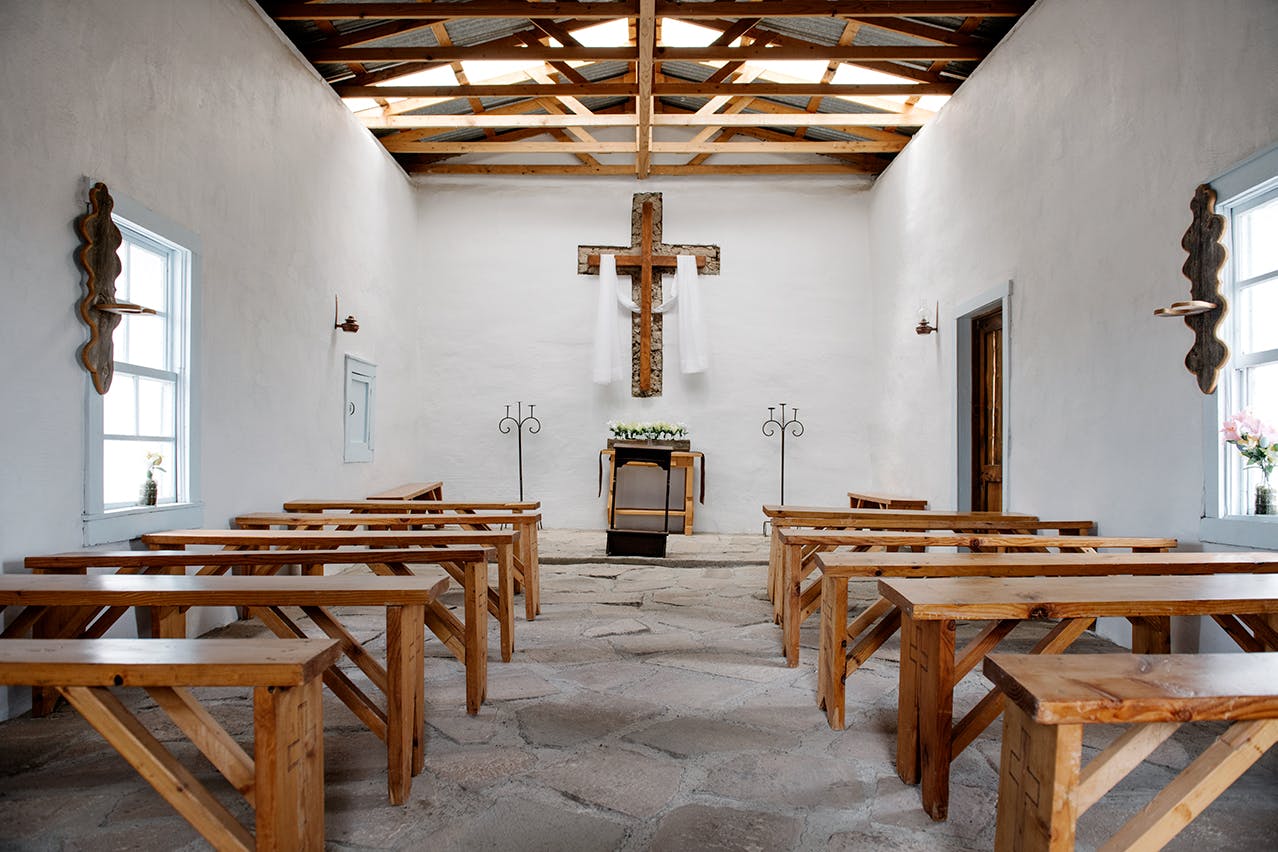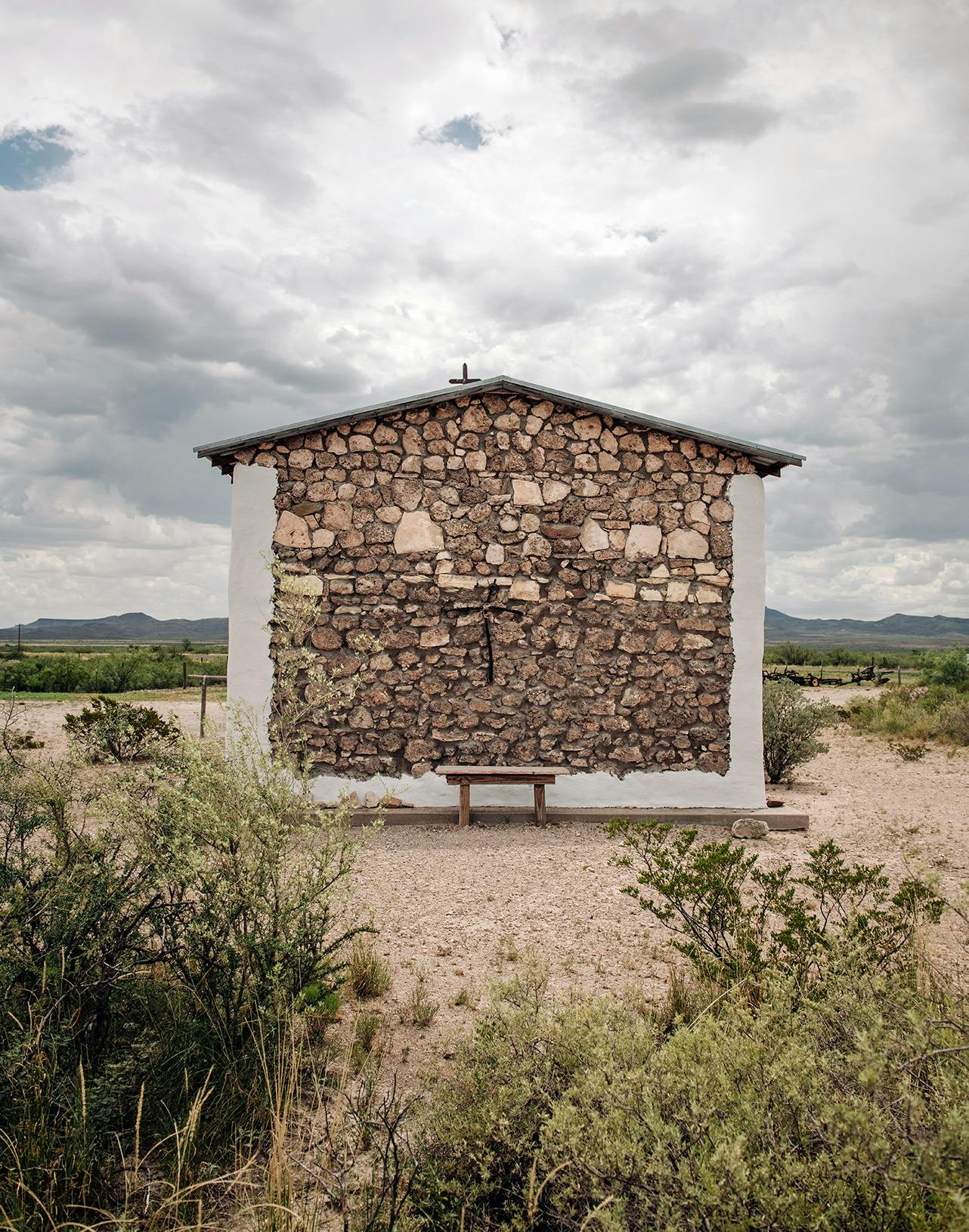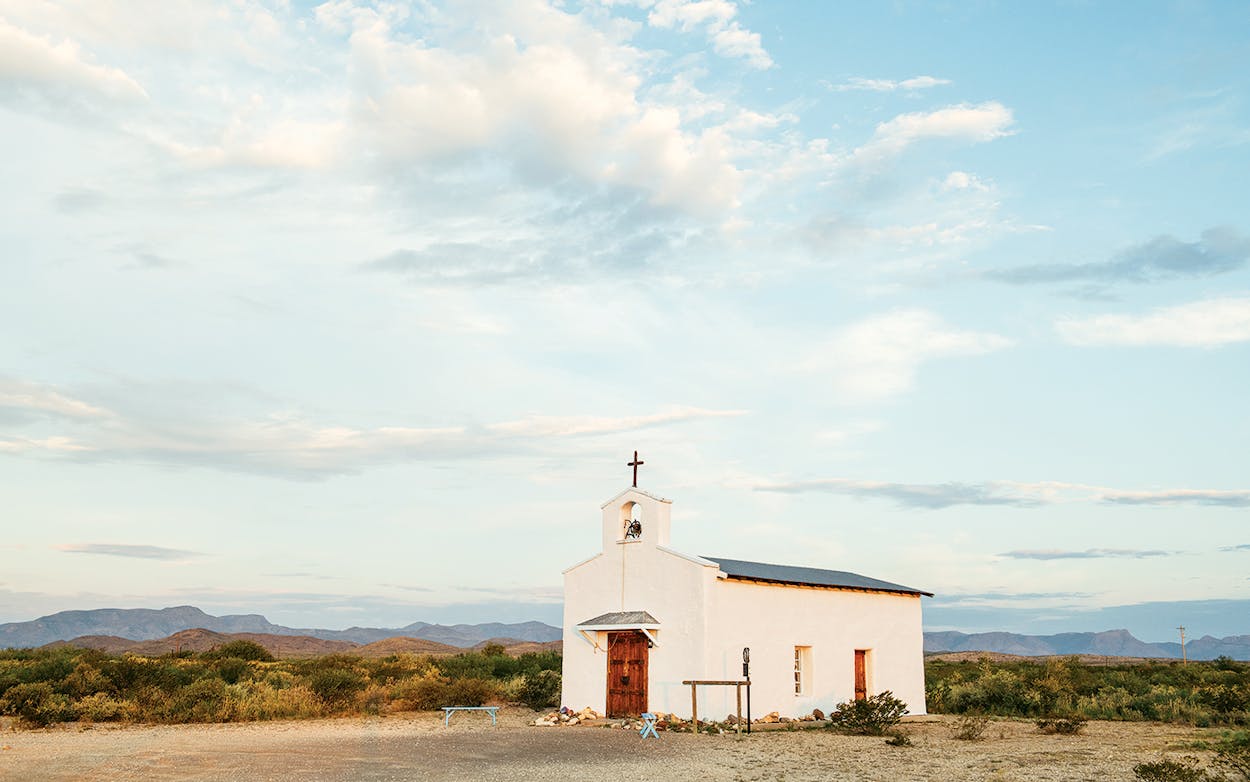All that’s left in the ghost town of Calera, about three miles west of Balmorhea State Park and fifty miles north of Marfa, is a church. The Calera Chapel emerges from the mesquite brush and desert sand along FM 3078. The minimalist structure absorbs the orange glow of the sunrise, gleams white in the midday sun, and takes on a purplish hue at dusk. Rocks surrounding the chapel are adorned with the signatures and initials of visiting families and couples—the West Texas version of a love lock.
These contrasts and the stark minimalism—the chapel consists of four adobe walls covered in stucco, punctuated by baby blue trim above the wooden door—bring to mind a certain artist who put nearby Marfa on the map. “It totally ranks among some of the most interesting structures aesthetically that (Donald) Judd built,” says Danny Smith, an art and architecture doctoral student at Stanford who featured images of the chapel in a 2017 exhibit in Palo Alto.
But Calera Chapel wasn’t the work of a master like Judd, the New York artist who installed minimalist structures in Marfa starting in the 1970s, or emulators like Michael Elmgreen and Ingar Dragset, who created the famed Prada Marfa. It is organic art. Art by chance.
Calera Chapel, originally called Mission Mary, was built by Mexican-American settlers in the early 1900s. A community of about one hundred people lived in Calera in ramshackle houses made from stone. They farmed and ranched the desert land, drawing water from the since dried-up Phantom Springs. Former resident Lupe Renteria Lyles described the community in the book Madera Valley 1870-1970: Irrigation Water to Drinking Water, by Darlene Ellison Chandler, as one where neighbors pitched in to provide whatever was needed. The chapel was one of many Catholic churches and missions in the Pecos region. A priest who hailed from the Netherlands named Nicholas Brocardus Eeken traveled by buggy to a series of small missions in Reeves, Pecos, Jeff Davis, Presidio, Brewster and Terrell counties. Every few weeks, he would come to Calera.

However, by the mid-twentieth century, after the last of Calera’s hundred or so residents abandoned the town in search of work, the chapel sat empty. It would be abandoned until the start of the twenty-first century.
In the early 1990s, a Parisian named Kate Vigneron fell in love with West Texas while visiting the ranch of her brother. She left France, where she had lived for almost thirty years with her late husband and had run a cake shop, and purchased a 4,000-acre slice of desert west of Balmorhea, where she raised Tennessee Walker horses and became a serial entrepreneur and philanthropist. On Balmorhea’s rundown Main Street, she opened a cafe and a retail store; she organized a women’s resource center, a “Keep Balmorhea Beautiful” campaign, and a local newsletter called The Balmorhea News.
One day in 2002, she was on the way to work when she felt the chapel calling. She heard something say “Restore me.” Says Vigneron: “I’m not a religious person, but I have a connection to something bigger than myself. Out in the desert, if you’re open to it, you do sense and feel things more than you do in a city or a place with trees.”
Unlike Vigneron, Pat Brijalba had spent almost his entire life in Reeves County. His father was a farmer. On hot summer days growing up, he and his friends would float on inner tubes in the canals of spring water that flowed into Balmorhea. As part of his job with West Texas Utilities, he read electricity meters near Calera once a month and often wondered about the deserted chapel. One morning, in 2002, he proposed renovating the chapel to Vigneron at her office space in downtown Balmorhea. It happened to be the same day Vigneron heard the chapel calling to her. “Destiny,” he says. They would go on to form the Calera Foundation to renovate the church.

Vigneron persuaded the owners of the land, who lived in Midland, to donate the property. Brijalba and former Balmorhea mayor Ruben Fuentes salvaged concrete from a nearby creek bed and set it into the floor in a rounded pattern. A bell for the belltower was donated by the town of Pecos. On one of her frequent trips to the Sierra Madre, Vigneron purchased a wooden cross from the Tarahumara. It’s about five feet tall and hangs on the back wall. Sun peeks in through a small opening remaining in the back of the chapel. Inside, amid six rows of pews, the smoky residue from previously lit devotional candles lingers in the air.
The Calera Chapel reopened in 2003 and is open to the public at all hours, except for private events—namely, weddings. The church can be reserved for $75 for matrimonial services, Brijalba says. The exterior also makes for an irresistible Instagram opportunity. Lora Webb, who produced the Calera Chapel installation at Stanford with Smith, says the porousness of the stucco catches the light and the shadows. “There’s a softening effect,” she says. “Just the fact that the building is so plain and so simple, it kind of takes on the effect of the environment without imposing its own structure more than it needs to.” Thus, when you pass by, you’ll often see pilgrims, couples, and wanderers posing for photos in front of the iridescent white church set against the ever-changing Texas sky.
A shorter version of this article originally appeared in the November 2019 issue of Texas Monthly with the headline “A Spiritual Oasis.” Subscribe today.
- More About:
- Balmorhea







